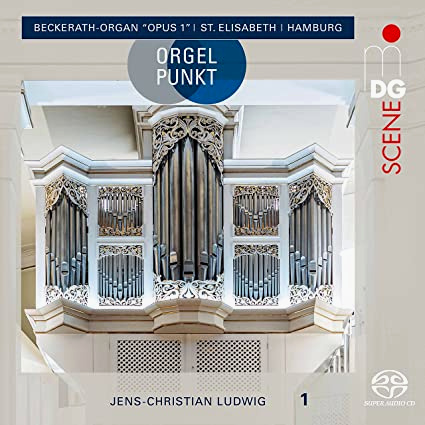

Marc Antoine Charpentier: Prelude from "Te Deum" Georg Friedrich Handel: "Arrival of the Queen of Sheba" Jeremiah Clarke: Trumpet Tune in D Jeremiah Clarke: The Prince of Denmark's March "Trumpet Voluntary" Georg Friedrich Handel: "Ombra mai fu" from Xerxes Johann Sebastian Bach: Toccata in C major, BWV 564 Carl Philipp Emanuel Bach: Hamburg Sonata in G major for Flute and Continuo, Wq 133 Johann Sebastian Bach: "Jesu, bleibet meine Freude", BWV 147 (arr. Maurice Duruflé) Georg Philipp Telemann: Konzert for Viola, Strings and Basso continuo in G major, TWV 51:G9 Bach/Charles Gounod: Ave Maria Johann Sebastian Bach: Concerto IV, BWV 595 - Aria "Schafe können sicher weiden" from BWV 208 - "Wachet auf, ruft uns die Stimme", BWV 645 - Toccata and Fugue in D minor, BWV 565
This new CD from the series of recordings titled Orgelpunkt (Organ Point) on the German label MDG is a delight to listen to from start to finish. And for me at least, was an unexpected but highly pleasant surprise. You see, whenever I receive a new recording be it as a physical CD or digital download, I like to dive straight away into the music without reading the booklet or liner notes, or using other recordings for comparison, simply to avoid preconceived notions that could alter my expectations. In other words I like to judge a recording on its own merits. So I think you will agree with me that when looking at the cover of this CD, one would expect to hear solo pipe organ music from the Baroque period. On the contrary, this is a perfectly curated program of well known Baroque music favorites, most of them masterfully arranged by organist Jens-Christian Ludwig either for voice and organ, or various instruments and organ.
Imagine my surprise when the first thing I hear is a stately timpany opening of Charpentier's Te Deum underpinning the regal trumpet stops of the organ. And it doesn't stop there. Jens-Christian Ludwig's sprightly arrangement for pipe organ of the Arrival of the Queen of Sheba with what sounds like the use of "Cornet" stops, is a thrill to hear. A nice change of pace is the beautiful setting for soprano (Veronika Pünder) and organ of Handel's famous aria Ombra mai fu, which also includes Torsten Lischke on violin, Jörg Thierfelder on flute and Jens Cyrkel on cello. One particular highlight here is the Konzert for Viola, Strings and Basso continuo by Telemann featuring Andrea Hummel on viola. Another is the highly convincing arrangement for pipe organ and harp of the famous Ave Maria by Charles Gounod in which harpist Chiara Amélie Ludwig plays the graceful arpeggiated chords and the organ intones the melody on gentle flute stops. And it wouldn't be an ideal recital without a few pieces for the pipe organ alone. And let me point out that Jens-Christian Ludwig's interpretation of the uber-famous Toccata and Fugue in D minor by Johann Sebastian Bach is a breath of fresh air. It seems to me that as this piece is getting older, it's also gaining weight. Too many organists performing it on larger, more modern instruments, try and impose some affected, dramatic elements on it which actually drag it down. Here on the other hand it's agile and nimble, and actually invigorating to hear.
Here's an overview of the organ used in this recording from the people at MDG: "Rudolf von Beckerath built his very first organ for the St. Elisabeth Church in Hamburg. The "Opus 1" of the later world-famous organ builder has recently been restored to its former glory. Despite the extensive expansion of the instrument, it can still be played unchanged in its original state due to a technical refinement. Beckerath's original specification of 1951 could not be fully realised at that time for reasons of cost. 11 stops on two manuals had to suffice. Seven more stops were added a few years later, and this is the extent to which the instrument existed until its restoration in 2019. The clever double console houses Beckerath's original console on one side and its modern counterpart with four manuals opposite, which control both the "old" organ and its extension. This is an ideal symbiosis between conservation of the monument and innovative function." It now boasts more than 60 stops ranging from a 2' Spitzflöte to a 32' Akustikbombarde. This series of recordings, including this previous release, is off to an impressive start.
Jean-Yves Duperron - October 2021